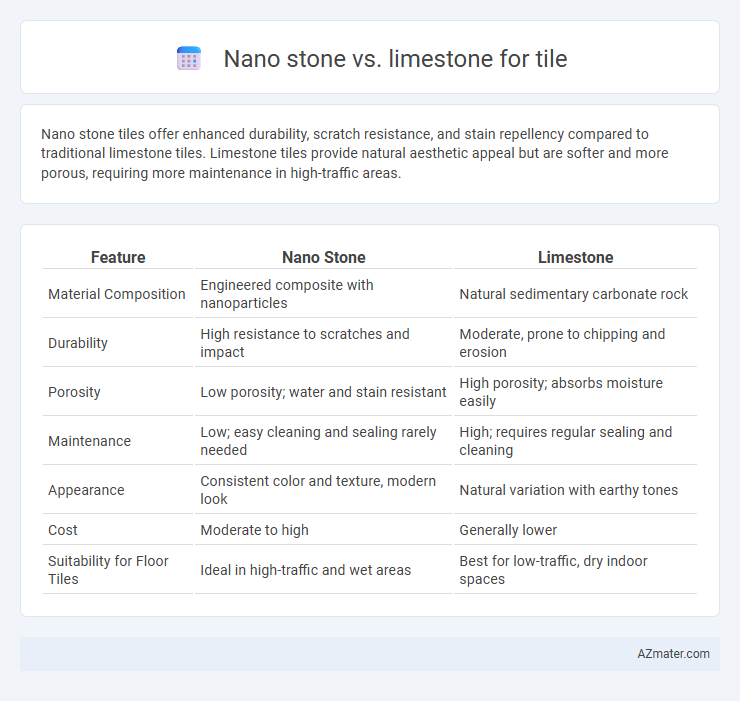Nano stone tiles offer enhanced durability, scratch resistance, and stain repellency compared to traditional limestone tiles. Limestone tiles provide natural aesthetic appeal but are softer and more porous, requiring more maintenance in high-traffic areas.
Table of Comparison
| Feature | Nano Stone | Limestone |
|---|---|---|
| Material Composition | Engineered composite with nanoparticles | Natural sedimentary carbonate rock |
| Durability | High resistance to scratches and impact | Moderate, prone to chipping and erosion |
| Porosity | Low porosity; water and stain resistant | High porosity; absorbs moisture easily |
| Maintenance | Low; easy cleaning and sealing rarely needed | High; requires regular sealing and cleaning |
| Appearance | Consistent color and texture, modern look | Natural variation with earthy tones |
| Cost | Moderate to high | Generally lower |
| Suitability for Floor Tiles | Ideal in high-traffic and wet areas | Best for low-traffic, dry indoor spaces |
Introduction to Nano Stone and Limestone Tiles
Nano stone tiles boast advanced engineered compositions combining natural minerals with nano-scale technology, enhancing durability, stain resistance, and surface smoothness compared to traditional materials. Limestone tiles, composed primarily of calcium carbonate, offer a natural, textured appearance with softer characteristics that require more maintenance due to porosity and susceptibility to etching. Selecting between nano stone and limestone tiles depends on the desired balance between modern performance benefits and classic natural aesthetics.
Composition and Formation: Nano Stone vs Limestone
Nano stone tiles are engineered using advanced nanotechnology, combining natural minerals with synthetic resins to create a highly durable and non-porous surface, while limestone tiles are formed from sedimentary rock primarily composed of calcium carbonate derived from marine organism fossils. Nano stone offers enhanced resistance to stains and scratches due to its compact molecular structure, whereas limestone's porous nature makes it more susceptible to moisture absorption and physical wear. The synthetic composition of nano stone allows for consistent quality and color, contrasting with the natural variability found in limestone formed through geological sedimentation processes.
Aesthetic Appeal and Design Versatility
Nano stone offers a sleek, highly polished surface with uniform consistency, enhancing modern aesthetic appeal and allowing for intricate patterns and vibrant color finishes. Limestone provides a natural, textured look with warm earth tones, favored for classic and rustic designs, yet it may require more maintenance due to its porous nature. Both materials deliver design versatility, but nano stone excels in contemporary, high-gloss installations while limestone suits traditional, matte or honed tile applications.
Durability and Strength Comparison
Nano stone tiles exhibit superior durability and strength due to their advanced compactness and resistance to wear, outperforming traditional limestone tiles which are softer and more prone to scratches and chipping. The nano stone's enhanced structural integrity makes it ideal for high-traffic areas and heavy-use applications, maintaining its appearance longer under stress. Limestone, while visually appealing with its natural texture, requires more maintenance and is less resistant to impact compared to nano stone alternatives.
Surface Finish and Texture Differences
Nano stone tiles feature a highly polished, smooth surface finish with a consistent, glass-like texture that enhances their modern aesthetic appeal and resistance to stains. Limestone tiles exhibit a more natural, matte to honed finish with a porous texture, providing a rustic, earthy look and requiring more maintenance due to susceptibility to moisture absorption. The surface finish and texture differences between nano stone and limestone significantly impact durability, cleaning, and visual style choices in tile applications.
Maintenance and Cleaning Requirements
Nano stone tiles require minimal maintenance due to their non-porous surface, which resists stains, dirt, and bacteria buildup, making cleaning quick and easy with just mild soap and water. Limestone tiles, being porous, demand regular sealing to prevent stains and require gentle cleaning with pH-neutral cleaners to avoid surface damage. The durability of nano stone against scratches and chemicals offers a more hassle-free upkeep compared to the frequent care limestone needs to maintain its appearance.
Water and Stain Resistance Properties
Nano stone tiles exhibit superior water and stain resistance due to their advanced nanotechnology coating that seals pores and prevents liquid absorption, making them ideal for high-moisture environments. Limestone, being a natural sedimentary rock, is inherently porous and more susceptible to water penetration and staining, often requiring regular sealing to maintain its durability and appearance. The enhanced impermeability of nano stone tiles ensures easier maintenance and longer-lasting aesthetic appeal compared to limestone tiles.
Environmental Impact and Sustainability
Nano stone tiles offer a more sustainable alternative to limestone as their production typically requires less quarrying, reducing habitat destruction and resource depletion. Limestone extraction involves significant environmental disruption, including carbon emissions and landscape degradation, impacting biodiversity negatively. Nano stone's longer lifespan and potential for recycling further enhance its environmental benefits compared to traditional limestone tiles.
Cost Comparison: Nano Stone vs Limestone Tiles
Nano stone tiles are generally more expensive than limestone tiles due to advanced manufacturing processes and enhanced durability features. Limestone tiles offer a more budget-friendly option, with lower initial costs but potentially higher maintenance expenses over time. Cost efficiency depends on project scale, with nano stone favored for long-term investment, while limestone suits cost-sensitive installations.
Best Applications and Use Cases
Nano stone tiles offer superior durability and stain resistance, making them ideal for high-traffic areas such as kitchens and commercial spaces. Limestone tiles provide a natural, elegant look with excellent thermal insulation, suited for living rooms and low-moisture environments. Nano stone's non-porous surface excels in wet areas like bathrooms, while limestone requires sealing to prevent water damage.

Infographic: Nano stone vs Limestone for Tile
 azmater.com
azmater.com